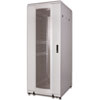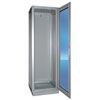Server, networking, automation, which cabinet to choose?

When you have to buy a rack cabinet some choices are optional and others obligatory but all revolve around the use that this cabinet will be made.
If the cabinet or rack you are looking for must accommodate servers, whether they are tower or rack-mount it will still be preferable, or inevitable, to buy a rack cabinet from the server line.The rack cabinets of the server line are characterized by some peculiarities such as:
All of the features listed above meet the obvious security, reliability, and convenience requirements that are essential when equipping your corporate network with a server rack cabinet.
Typically, 1- and 2-drive rack server frames are close to 720 mm deep, so all server rack cabinets are 1000 mm deep. In fact, on such cabinets the internal rack posts are placed on a depth distance of about 720 mm.

Rack cabinets for networking are characterized by:
Networking cabinets generally contain peripherals that are less bulky than servers and with less cooling requirements, this allows you to use smaller and more "closed" cabinets ensuring high safety, reliability and high sound insulation.
The dimensions of the cabinet (for example: 26 units (h)1340 x (w)600 (d)1000 mm] always refer to the external footprint while internally a useful space in depth, width and height, significantly lower, must be considered.
As far as width is concerned, there are usually no problems since the internal width between the rack posts (19 inches) is one of the founding values of the standard rack on which the whole system is based.
The same goes for the height of the cabinet, data provided for the purpose of evaluating its size while its internal usability is calculated in terms of the number of rack units that can be accommodated, in the example cited above 26u.
The problem arises instead because of the depth on which misunderstandings often arise.
Generally a rack cabinet has a useful internal space in depth, about 200mm less than the external depth of the cabinet. This difference is motivated by the need to be able to insert cables into rack-mounted objects: power cables, monitor and keyboard behind the server, or network cables in front of patch panels and/or switches.
For these reasons, the rack posts are also positioned on average at a depth distance of 250/280 mm less than the external depth of the cabinet. On many cabinets this adjustment of the uprights is widely modifiable but what has just been said remains valid about the spaces necessary for the wiring of the different objects mounted in racks, one of the classic errors in which you fall when choosing a rack is that of underestimating your needs.
The IP Ratings classification is a standard that identifies the level of protection of an object against solids and liquids.
For example, IP41 means: protected against solid bodies larger than 1.0mm and protected against vertical droplets of water
|
0 |
unprotected |
|
1 |
protected against solid objects larger than 50mm |
|
2 |
protected against solids larger than 12mm |
|
3 |
protected against solid objects larger than 2.5mm |
|
4 |
protected against solids larger than 1.0mm |
|
5 |
dust-protected (limited entry) |
|
6 |
fully protected against dust |
|
0 |
unprotected |
|
1 |
protected against vertical droplets of water |
|
2 |
protected against falling water droplets at an inclination of 15° |
|
3 |
protected against falling water droplets at an inclination of 60° |
|
4 |
protected against splashing water from all directions |
|
5 |
protected against low-pressure water jets from all directions |
|
6 |
protected against waves |
|
7 |
protected against the effects of immersion between 15cm and 1m |
|
8 |
protected against the effects of prolonged immersion |
subrack.eu + armadi-rack.it© are run by M.D.W. srl - About Us
M.D.W. srl Chamber of Commerce, Bologna
REA n° 465866
PI/CF 02766841205
Legal office:Piazza Minghetti, 4/D
Bologna 40124 BO, Italy
Operating office:Via Edmondo De Amicis 7
Casalecchio di Reno 40033 BO, Italy